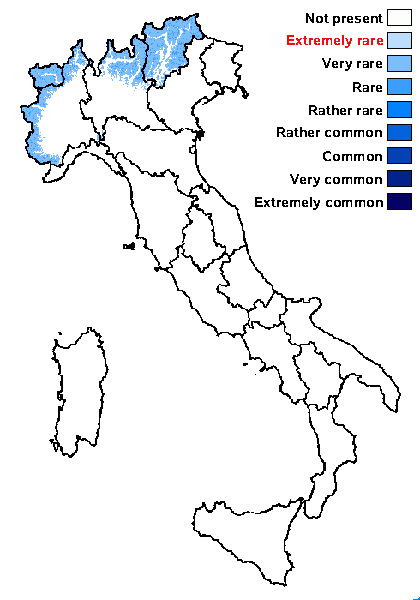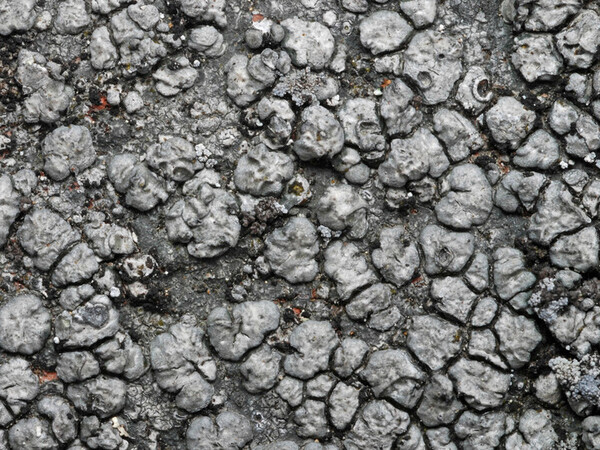Circinaria gibbosa (Ach.) A. Nordin, Savić & Tibell
Mycologia, 102: 1346, 2010. Basionym: Urceolaria gibbosa Ach. - Meth. Lich.: 144, 1803.
Synonyms: Aspicilia gibbosa (Ach.) Körb.; Lecanora gibbosa (Ach.) Nyl.
Distribution: N - TAA (Nascimbene & al. 2022), Lomb, Piem, VA (TO 1786).
Description: Thallus crustose, episubstratic, verrucose-areolate, yellowish grey to bluish-grey, sometimes delimited by a dark prothallus, the areoles 0.6-1 mm wide, usually rounded, convex, developing on a dark hypothallus. Medulla white, filled with crystals, opaque, I-. Apothecia aspicilioid, 0.3-0.6 mm across, immersed, usually 1 per areole, with a black, epruinose, flat disc, and a very thin, persistent, often split thalline margin. Proper exciple poorly developed, colourless, up to 25 µm wide; epithecium olive green to olive-brown, N+ green, K+ yellow-brown; hymenium colourless, 120-150(-185) µm high, I+ blue or sometimes partly turning yellow-green; paraphyses 7-2.5 µm thickat mid-level, slightly branched, anastomosing and submoniliform in upper part, the apical cells to 3.5 µm wide; hypothecium colourless, I+ blue. Asci 6-8-spored, cylindrical-clavate, the thin outer coat K/I+ blue, the wall and apical dome K/I-. Ascospores 1-celled, hyaline, broadly ellipsoid to subglobose, 20-26 x 12-14(-18) µm. Pycnidia partially immersed, with a black, punctiform ostiole. Conidia thread-like, 6-8 x c. 1 µm. Photobiont chlorococcoid. Spot tests: cortex K-, C-, KC-, P-; medulla K+ yellow turning red (needle-like red crystals), but only after pretreatment with HCl. Chemistry: aspicilin, medulla with norstictic acid in low concentrations.Note: on siliceous rocks wetted by rain in the mountains. The epithet gibbosa was frequently used by European authors for C. caesiocinerea, so that the presence of this northern species in the Alps is dubious.
Growth form: Crustose
Substrata: rocks
Photobiont: green algae other than Trentepohlia
Reproductive strategy: mainly sexual
Commonnes-rarity: (info)
Alpine belt: very rare
Subalpine belt: rare
Oromediterranean belt: absent
Montane belt: very rare
Submediterranean belt: absent
Padanian area: absent
Humid submediterranean belt: absent
Humid mediterranean belt: absent
Dry mediterranean belt: absent

Predictive model
Herbarium samples
Growth form: Crustose
Substrata: rocks
Photobiont: green algae other than Trentepohlia
Reproductive strategy: mainly sexual
Commonnes-rarity: (info)
Alpine belt: very rare
Subalpine belt: rare
Oromediterranean belt: absent
Montane belt: very rare
Submediterranean belt: absent
Padanian area: absent
Humid submediterranean belt: absent
Humid mediterranean belt: absent
Dry mediterranean belt: absent

Predictive model
| Herbarium samples |
 INDEX FUNGORUM
INDEX FUNGORUM
 GBIF
GBIF
 DOLICHENS
DOLICHENS


